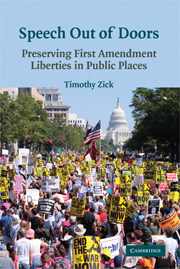Book contents
- Frontmatter
- Contents
- List of Figures
- Preface
- Acknowledgments
- SPEECH OUT OF DOORS
- 1 Introduction: The Geography of Expression
- 2 The Expressive Topography and Public Liberties
- 3 Embodied Places
- 4 Contested Places
- 5 Non-Places
- 6 Inscribed Places
- 7 Militarized Places
- 8 Places of Higher Learning
- 9 Networked Public Places
- Epilogue
- Index
- References
1 - Introduction: The Geography of Expression
Published online by Cambridge University Press: 05 June 2012
- Frontmatter
- Contents
- List of Figures
- Preface
- Acknowledgments
- SPEECH OUT OF DOORS
- 1 Introduction: The Geography of Expression
- 2 The Expressive Topography and Public Liberties
- 3 Embodied Places
- 4 Contested Places
- 5 Non-Places
- 6 Inscribed Places
- 7 Militarized Places
- 8 Places of Higher Learning
- 9 Networked Public Places
- Epilogue
- Index
- References
Summary
The 2004 Democratic National Convention in Boston was a critical democratic moment. Delegates were gathering at the Fleet Center to choose a presidential nominee. Opponents of the nominees and various party detractors also intended to assemble there, to demonstrate and protest. Quite naturally, these speakers wanted to be both seen and heard – by the delegates and others near the Fleet Center. They also wanted the media to notice their assemblies and report on their criticisms and causes. Federal and local officials constructed a place for this purpose. The “Demonstration Zone (DZ)”, as it came to be known, was located within a “hard” security zone around the immediate perimeter of the Fleet Center. This “hard” zone was located within a larger “soft” security zone stretching beyond the Fleet Center.
The DZ was an oppressive architecture. Barricades and fences marked its perimeters. Two layers of thick mesh were added to this imposing and restrictive shell. To prevent anyone from climbing out of the “pen” or “cage,” as many demonstrators referred to it, officials placed coiled razor wire at its apex. National Guardsmen were strategically positioned to observe any activity within the DZ, and presumably to respond to any threats to public safety and order. Once inside, speakers would have no meaningful access to the delegates. No leaflets or other materials could be passed. No signs of any appreciable size would be allowed into the zone.
- Type
- Chapter
- Information
- Speech Out of DoorsPreserving First Amendment Liberties in Public Places, pp. 1 - 24Publisher: Cambridge University PressPrint publication year: 2008



